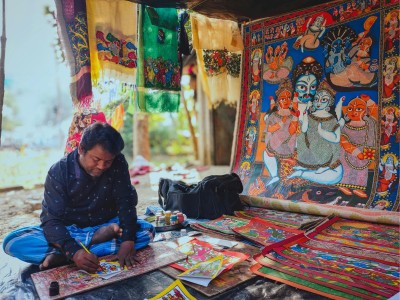Preserving Culture: The Importance of Protecting Traditions
-1745572320.jpg)
In a rapidly changing world, where globalization and modernity are constantly shaping societies, the preservation of cultural traditions has become an increasingly significant challenge. While embracing progress and innovation is crucial for societal development, maintaining a connection to cultural heritage ensures that the diverse identities, values, and practices that define human societies are not lost in the tide of change. From language and rituals to arts, crafts, and customs, culture is the bedrock of identity, offering individuals a sense of belonging and continuity with their ancestors. Preserving culture is not just about maintaining the past; it is about ensuring that future generations inherit a rich, diverse heritage that continues to shape their worldview.
1. Cultural Heritage as an Identity Anchor
Culture is much more than an abstract concept—it is the foundation of personal and collective identity. Traditions, language, art, music, and food are all expressions of a community's historical journey, values, and beliefs. By preserving these cultural markers, societies safeguard their unique identities and offer future generations a sense of connection to their past.
The Role of Language in Preserving Culture
Language is one of the most vital aspects of cultural heritage, as it is the primary means by which knowledge, traditions, and customs are passed down. Many indigenous languages, however, are at risk of extinction, with fewer people speaking them as younger generations adopt global languages such as English or Spanish. When a language dies, so too do the stories, traditions, and ways of thinking that are uniquely tied to it.
Efforts to revitalize and preserve endangered languages, such as through educational programs and media outreach, are vital for ensuring that these languages—and the cultural knowledge they carry—are not lost forever. Language is a living expression of culture, and by keeping it alive, communities maintain a powerful link to their history.
2. The Importance of Rituals and Customs
Rituals, ceremonies, and customs are integral parts of cultural identity, helping individuals connect to their ancestors, community, and spiritual beliefs. These practices often serve as markers of significant life events, such as births, marriages, and deaths, and they provide a framework for understanding the cycles of life, nature, and the cosmos.
Religious and Spiritual Practices
Many traditional religious and spiritual practices, which have been passed down for generations, are deeply embedded in a community's culture. For example, in Hinduism, the practice of performing pujas (rituals) in temples or at home is not only a religious act but also a way of preserving cultural customs that have endured for thousands of years. These rituals are a way of maintaining a sense of continuity, offering individuals a tangible connection to their faith and cultural identity.
As societies modernize, however, these traditional practices often face the threat of fading away. To preserve such rituals, communities and organizations are taking proactive measures to ensure that younger generations understand their significance and continue to practice them in the face of globalization.
3. The Role of Art and Craftsmanship
Art and craftsmanship are essential aspects of a society's culture, providing tangible expressions of creativity and tradition. From ancient sculptures to contemporary paintings, from handwoven textiles to pottery, traditional arts and crafts offer insight into a society’s values, aesthetics, and history. These forms of artistic expression are not only aesthetically significant but also carry deep cultural meanings, often tied to rituals, social structure, and the environment.
Reviving Traditional Crafts
In many societies, traditional crafts such as weaving, pottery, and embroidery have been passed down from generation to generation. However, as industrialization and mass production dominate the global market, the demand for handmade, traditional goods has decreased, threatening the survival of these skills. Efforts to revive and sustain these crafts, through workshops, exhibitions, and markets, are vital in ensuring that these traditions remain a part of modern life.
For instance, the intricate art of pottery in places like Japan and Mexico continues to thrive thanks to efforts to preserve indigenous techniques and to incorporate them into contemporary designs. By valuing and protecting these arts, communities can maintain a tangible connection to their history while adapting to modern challenges.
4. Cultural Practices in the Face of Globalization
Globalization, while offering opportunities for cross-cultural exchange and economic growth, also poses challenges for the preservation of traditional cultures. The rapid spread of global culture through media, technology, and commerce often leads to the homogenization of cultures, where local customs and traditions are overshadowed by dominant global influences. This cultural erosion can lead to a loss of identity, particularly for marginalized and indigenous communities.
Balancing Tradition and Modernity
It is essential to find a balance between embracing modernity and preserving cultural heritage. This can be achieved through initiatives that promote cultural diversity and encourage the practice and celebration of traditional customs alongside modern developments. Governments, NGOs, and cultural organizations play a significant role in facilitating this balance by supporting local communities in their efforts to preserve their cultural heritage while adapting to the demands of the modern world.
An example of this can be seen in Bhutan, where the government has introduced policies that aim to protect traditional culture while still allowing for technological advancements and modernization. Bhutan's focus on preserving its unique culture and identity—while promoting sustainable tourism and economic development—offers a model for how traditional and modern values can coexist.
5. Cultural Heritage as an Educational Tool
Preserving culture is not only about protecting the past; it is also about educating future generations. Cultural heritage serves as a living classroom, offering lessons in history, ethics, and social values. By teaching young people about their cultural traditions, communities can ensure that these practices continue to thrive in future generations.
Cultural Education in Schools
Many countries have begun to incorporate cultural education into school curricula, encouraging students to learn about their own heritage as well as the traditions of other cultures. In New Zealand, for instance, the teaching of Māori language and customs in schools has been pivotal in preserving the indigenous culture while promoting national unity. Similarly, in Africa, efforts to teach indigenous languages and traditions in schools are helping preserve cultural diversity and identity.
By incorporating cultural heritage into education systems, societies can help young people understand the value of their traditions and empower them to carry these practices forward in their own lives.
6. The Role of Technology in Cultural Preservation
In the digital age, technology can play a key role in preserving cultural traditions. Through digital archives, virtual museums, and online platforms, cultural practices, languages, and arts can be shared with global audiences, ensuring their preservation for future generations.
Digital Preservation of Cultural Artifacts
Many cultural institutions around the world are using technology to digitize and preserve ancient manuscripts, artworks, and artifacts that might otherwise be lost to time or natural disasters. By creating digital copies of these items, museums and universities ensure that future generations can access them, even if the physical objects are no longer available.
Similarly, technology can help in the revitalization of endangered languages. Apps, websites, and online language courses are now being used to teach and promote the use of languages that are at risk of extinction, enabling people worldwide to learn and communicate in these languages.
The Necessity of Cultural Preservation
In a world that is increasingly interconnected and fast-paced, the need to preserve cultural traditions has never been more urgent. Culture is not a static relic of the past; it is a living, evolving force that shapes our identities and our future. By safeguarding traditional practices, languages, art, and rituals, we ensure that future generations have access to the richness and diversity of human experience. At the same time, preserving culture allows societies to remain rooted in their values and beliefs, providing them with a strong sense of identity in an ever-changing world.
Cultural preservation is not just a responsibility for governments or cultural organizations—it is a shared duty for individuals, communities, and societies at large. By working together to protect traditions, we can ensure that the colorful tapestry of human heritage continues to thrive for generations to come.

Mithila Magic: The Empowering Art of Nepali Women
-1745569776.jpg)
Global Inspirations: The Cross-Cultural Exchange of Art
-1745569773.jpg)


-1745569774.jpg)

-1745569762.jpg)
-1745569762.jpg)
-1745569769.jpg)
-1745569771.jpg)